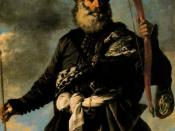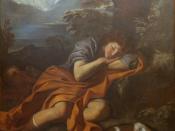Mola, Pier Francesco. The Vision of St. Bruno. The J. Paul Getty Museum, Los Angeles. J. Paul Getty Museum: Handbook of the Collections. By Mollie Holtman. Los Angeles: Christopher Hudson, 1997. Pg. 108.
Pier Francesco Mola is one of the most famous artists of the 17th century. He lived from 1612 to 1666. He is well known for his moving landscapes and baroque style. Baroque paintings have the characteristics of artistic expression that is marked generally by use of complex forms, bold ornamentation, and the juxtaposition of contrasting elements often conveying a sense of drama, movement, and tension. Mola used these characteristics to his advantage proving that he could incorporate the style into many different scenes. His inspirations came mostly from the works of early Venetian painters. He eventually won approval among his colleagues in Rome for his religious subjects. His works of illustrations of blue skies has influenced many of his progenies having been less concerned with proportions and placement than the placement of light and shade onto the objects.
In this painting the theme of Baroque art is personified into St. Bruno gazing upward dumfounded by the smiling angel faces that linger in the clouds. Mola depicts the saint during his religious journey into the wilderness in search of spiritual and self actualization. The Baroque-style coloring and emotional subject matter Mola is famous for is cleverly depicted in the radiant landscape and draperies. Placed next to St. Bruno is a cross and a crucifix. The cross is apparently symbolic of the crucifixion and the skull suggests death. When placed next to the cross the skull is specifically placed to emphasize the glory of Christ. The skull is faced downward into the cross looking almost as if the skull is leaning in to kiss the cross in...


